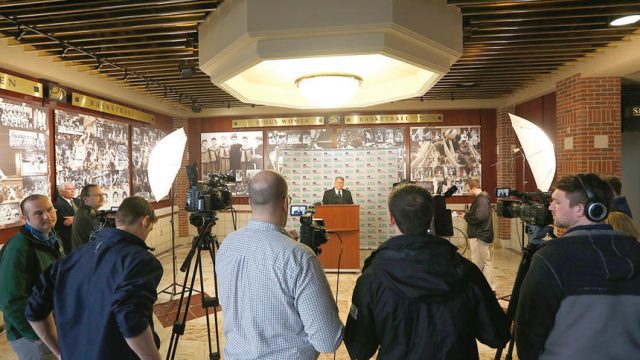At UND Sports Programs Lost Over $13.3 Million in 2016

UND Athletics Director Brian Faison answers questions from the media about cuts to the athletic department Tuesday afternoon at the Betty Engelstad Sioux Center. Jesse Trelstad/ Grand Forks Herald
 With the controversy over cutting the women’s hockety team at the University of North Dakota making headlines I’ve had a lot of people asking me about the financial status of other sports teams both at UND and rival North Dakota State University.
With the controversy over cutting the women’s hockety team at the University of North Dakota making headlines I’ve had a lot of people asking me about the financial status of other sports teams both at UND and rival North Dakota State University.
I put in requests for information to both schools, and while I don’t have NDSU’s information yet I got the data from UND this morning while I was writing my latest post about the women’s hockey team.
You can read the whole document below, and the numbers aren’t pretty. If we exclude institutional aid and student fees, which are rather conveniently counted as “revenues” for these programs, we see that overall the school’s sports programs lost over $13.3 million even after counting money from things like ticket sales, merchandising deals, and broadcast arrangements.
You can see a the raw numbers in the image above. Keep in mind, again, that I subtracted the subsidies (institutional aid and student fees) so that we could get a clear picture based on the revenues sports actually produces.
Here’s how it looks in graph form:
The baseball and men’s golf programs were cut last year. Earlier this year men’s and women’s swimming were cut along with the women’s hockey program.
There are a couple of additional things worth noting from this data.
First is that football lost a lot more money than women’s hockey in 2016 even though the sport was far more popular (as measured by game attendance).
Second is that even the men’s hockey team, by far the most popular sport at UND, lost money.
Now, to be fair, there is a category for sports programs revenues which aren’t attributed to any one sport. This is for things like sales of UND merchandise which can often be hard to tie to any one specific sports team.
UND raked in over $6.7 million in that category of revenues, which would go a long way toward addressing the revenue deficiencies of the individual sports programs, except that UND also had over $6.5 million in expenses not associated with any of the sports.
That leaves just $135,000 in positive revenues from this general category. Which could wipe out the losses for Men’s Tennis and, well, that’s about it.
Student loan debt is a national epidemic. Here in the state, lawmakers are squabbling over budget line items. “Do we want sports or drug counseling?” a friend asked me this morning when I shared these numbers with him. “Because we are at that point.”
Collegiate sports fans have created a myth over the years about how successful sports programs are a boon to their host schools. But the truth is that, financially, they represent a heavy financial burden for their institutions.
A burden ultimately carried by students and taxpayers.
[scribd id=344022985 key=key-Tf5gkT3PrWaRQJdYfuKd mode=scroll]




